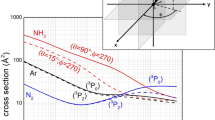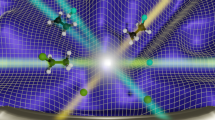Abstract
The concept of geometrical constraints and steric hindrance in reactions is implanted deeply in a chemist's ‘chemical intuition’. However, until now a true three-dimensional view of these steric effects has not been realized experimentally for any chemical reaction in full. Here we report the complete three-dimensional characterization of the sterics of a benchmark polyatomic reaction by measuring the dependence of the product state-resolved angular distributions on the spatial alignment of the reactive bond in a crossed molecular beam experiment. The results prove the existence of two distinct microscopic reaction mechanisms. Detailed analysis reveals that the origin of the stereodynamics in the HCl(ν = 0) + CD3(00) product channel can be captured by a textbook line-of-centres collision model. In contrast, a time-delay pathway, which includes a sharp switch from in-plane to out-of-plane scattering in the forwards direction, appears to be operative in forming the excited HCl(ν = 1) + CD3(00) product pair.
This is a preview of subscription content, access via your institution
Access options
Subscribe to this journal
Receive 12 print issues and online access
$259.00 per year
only $21.58 per issue
Buy this article
- Purchase on Springer Link
- Instant access to full article PDF
Prices may be subject to local taxes which are calculated during checkout




Similar content being viewed by others
References
Levine, R. D. & Bernstein, R. B. Molecular Reaction Dynamics and Chemical Reactivity (Oxford Univ. Press, 1987).
Beuhler, R. J. Jr, Bernstein, R. B. & Kramer, K. H. Observation of the reactive asymmetry of methyl iodide: crossed beam study of the reaction of rubidium with oriented methyl iodide molecules. J. Am. Chem. Soc. 88, 5331–5332 (1966).
Parker, D. H. & Bernstein, R. B. Oriented molecule beam via the electrostatic hexapole: preparation, characterization, and reactive scattering. Annu. Rev. Phys. Chem. 40, 561–595 (1989).
Brooks, P. R. & Jones, E. M. Reactive scattering of K atoms from oriented CH3I molecules. J. Chem. Phys. 45, 3449–3450 (1966).
Brooks, P. R. Reactions of oriented molecules. Science 193, 11–16 (1976).
Zare, R. N. Optical preparation of aligned reagents. Ber. Bunsenges. Phys. Chem. 86, 422–425 (1982).
Orr-Ewing, A. J. Dynamical stereochemistry of bimolecular reactions. J. Chem. Soc. Faraday Trans. 92, 881–900 (1996).
Alexander, A. J., Brouard, M., Kalogerakis, K. S. & Simons, J. P. Chemistry with a sense of direction – the stereodynamics of bimolecular reactions. Chem. Soc. Rev. 27, 405–415 (2007).
Loesch, H. J. & Stienkemeier, F. Steric effects in the state specific reaction Li + HF(ν = 1, j = 1, m = 0) → LiF + H. J. Chem. Phys. 98, 9570–9584 (1993).
Loesch, H. J. Orientation and alignment in reactive beam collisions: recent progress. Annu. Rev. Phys. Chem. 46, 555–594 (1995).
Wade, E. A. et al. Ion imaging studies of product rotational alignment in collisions of NO(2Π1/2, j = 0.5) with Ar. Chem. Phys. 301, 261–272 (2004).
Simpson, W. R., Rakitzis, T. P., Kandel, S. A., Orr-Ewing, A. J. & Zare, R. N. Reaction of Cl with vibrationally excited CH4 and CHD3: state-to-state differential cross sections and steric effects for the HCl product. J. Chem. Phys. 103, 7313–7335 (1995).
Kandel, S. A. et al. Cl + HD(ν = 1; j = 1, 2) reaction dynamics: comparison between theory and experiment. J. Chem. Phys. 112, 670–685 (2000).
Wang, F., Lin, J-S. & Liu, K. Steric control of the reaction of CH stretch-excited CHD3 with chlorine atom. Science 331, 900–903 (2011).
Zhang, W., Kawamata, H. & Liu, K. CH stretching excitation in the early barrier F + CHD3 reaction inhibits CH bond cleavage. Science 325, 303–306 (2009).
Wang, F. & Liu, K. Enlarging the reactive cone of acceptance by exciting the C–H bond in the O(3P) + CHD3 reaction. Chem. Sci. 1, 126–133 (2010).
Aldegunde, J. et al. How reactants polarization can be used to change and unravel chemical reactivity. J. Phys. Chem. A 109, 6200–6217 (2005).
Shafer-Ray, N. E., Orr-Ewing, A. J. & Zare, R. N. Beyond state-to-state differential cross sections: determination of product polarization in photoinitiated bimolecular reactions. J. Phys. Chem. 99, 7591–7603 (1995).
Brouard, M. & Vallance, C. Tutorials in Molecular Reaction Dynamics Ch. 9 (The Royal Society of Chemistry, 2010).
Orr-Ewing, A. J., Simpson, W. R., Rakitzis, T. P. & Zare, R. N. Preparing reagents: time dependence of HCl(ν = 1, J) alignment following pulsed infrared excitation. Isr. J. Chem. 34, 95–102 (1994).
Yan, S., Wu, Y-T., Zhang B., Yue, X-F. & Liu, K. Do vibrational excitations of CHD3 preferentially promote reactivity toward the chlorine atom? Science 316, 1723–1726 (2007).
Zhou, J., Zhang, B., Lin, J. J. & Liu, K. Imaging the isotope effects in the ground state reaction of Cl + CH4 and CD4 . Mol. Phys. 13, 1757–1763 (2005).
Aldegunde, J., Aoiz, F. J. & de Miranda, M. P. Quantum mechanical limits to the control of atom–diatom chemical reactions through the polarization of the reactants. Phys. Chem. Chem. Phys. 10, 1139–1150 (2008).
Czako, G. & Bowman, J. M. Dynamics of the reaction of methane with chlorine atom on an accurate potential energy surface. Science 334, 343–346 (2011).
Czako, G. & Bowman, J. M. Accurate ab initio potential energy surface, thermochemistry, and dynamics of the Cl(2P, 2P3/2) + CH4 → HCl + CH3 and H + CH3Cl reactions. J. Chem. Phys. 136, 044307 (2012).
Wang, X., Ben-Nun, M. & Levine, R. D. Peripheral dynamics of the Cl + CH4 → HCl + CH3 reaction: a classical trajectory computation. Chem. Phys. 197, 1–17 (1995).
Zhang, B. & Liu, K. Imaging a reactive resonance in the Cl + CH4 reaction. J. Chem. Phys. 122, 101102 (2005).
Yan, S., Wu, Y-T. & Liu, K. Tracking the energy flow along the reaction path. Proc. Natl Acad. Sci. USA 105, 12667–12672 (2008).
Martinez, R., Gonzalez, M., Defazio, P. & Petrongolo, C. Searching for resonances in the reaction Cl + CH4 → HCl + CH3: quantum versus quasiclassical dynamics and comparison with experiments. J. Chem. Phys. 127, 104302 (2007).
Remmert, S. M., Banks, S. T., Harvey, J. M., Orr-Ewing, A. J. & Clary, D. C. Reduced dimensionality spin-orbit dynamics of CH3 + HCl → CH4 + Cl on ab initio surfaces. J. Chem. Phys. 134, 204311 (2011).
Manolopoulos, D. E. Chemical physics: a delay reaction. Nature 419, 266–267 (2002).
Connor, J. N. L. Theory of forward glory scattering for chemical reactions. Phys. Chem. Chem. Phys. 6, 377–390 (2004).
Lin, J. J., Zhou, J., Shiu, W. & Liu, K. Application of time-sliced ion velocity imaging to crossed molecular beam experiments. Rev. Sci. Instrum. 74, 2495–2500 (2003).
Lin, J. J., Zhou, J., Shiu, W. & Liu, K. State-specific correlation of coincident product pairs in the F + CD4 reaction. Science 300, 966–969 (2003).
Yoder, B. L., Bisson, R. & Beck, R. D. Steric effects in the chemisorptions of vibrationally excited methane on Ni(100). Science 329, 553–556 (2010).
Acknowledgements
We thank J-S. Lin and C-M. Yang for assisting with the experiment. K.L. acknowledges M.P. de Miranda and F.J. Aoiz for clarifying the angular asymmetry of S1+2(θ). This work was supported by the National Science Council of Taiwan, Academia Sinica and the Air Force Office of Scientific Research (Grant No. AOARD-12-4020).
Author information
Authors and Affiliations
Contributions
K.L. conceived and designed the experiments and F.W. performed the experiments and analysed the data. F.W., T.P.R. and K.L. contributed to the analysis methods, discussed the results and commented on the manuscript. K.L. wrote the paper.
Corresponding author
Ethics declarations
Competing interests
The authors declare no competing financial interests.
Supplementary information
Supplementary information
Supplementary information (PDF 450 kb)
Rights and permissions
About this article
Cite this article
Wang, F., Liu, K. & Rakitzis, T. Revealing the stereospecific chemistry of the reaction of Cl with aligned CHD3(ν1 = 1). Nature Chem 4, 636–641 (2012). https://doi.org/10.1038/nchem.1383
Received:
Accepted:
Published:
Issue Date:
DOI: https://doi.org/10.1038/nchem.1383
This article is cited by
-
Fermi-phase-induced interference in the reaction between Cl and vibrationally excited CH3D
Nature Chemistry (2022)
-
Side-impact collisions of Ar with NO
Nature Chemistry (2019)
-
Observation of correlated excitations in bimolecular collisions
Nature Chemistry (2018)
-
Imaging quantum stereodynamics through Fraunhofer scattering of NO radicals with rare-gas atoms
Nature Chemistry (2017)
-
Direct mapping of the angle-dependent barrier to reaction for Cl + CHD3 using polarized scattering data
Nature Chemistry (2017)



